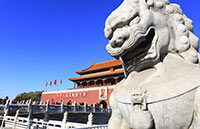China's bad loan risks controllable: central bank governor
Updated: 2016-10-09 16:06
(Xinhua)
|
||||||||
BEIJING -- China's central bank governor has said risks in the country's banking system are controllable despite an increase in bad loans, while reaffirming the role of monetary and fiscal stimulus in crisis handling.
Although Chinese banks have seen their dud loans rise, they have sufficient capital to cope and, overall, the risks can be controlled, Zhou Xiaochuan, governor of the People's Bank of China (PBOC), was quoted as saying by a PBOC statement released Sunday.
He made the remarks while attending the World Bank-International Monetary Fund annual meetings held in Washington from Friday to Sunday, according to the statement.
The comments came as China's rapid credit growth raised concerns about the quality of banking assets and a possible real estate bubble.
Chinese banks' non-performing loan ratio rose to 1.75 percent at the end of June, stable from a quarter earlier but up from 1.67 percent at the end of 2015, with bad loans reaching 1.44 trillion yuan, according to official data.
In August, China's new yuan-denominated lending more than doubled from a month earlier to 948.7 billion yuan (about $145.95 billion), with mortgages representing 55.7 percent of the 529 billion yuan in household loans.
Zhou said the fast credit expansion reflected China's efforts to tackle risks and prop up the economy against the backdrop of lackluster global growth.
China will control its credit growth as the global economy heads for a steady recovery, Zhou said, reiterating views he stated earlier at a meeting of G20 finance ministers and central bank governors.
China's experience has demonstrated that timely fiscal and monetary stimulus can play a positive role in coping with the crisis, Zhou said.
Major economic indicators have shown signs of improvement recently and the fundamentals for long-term, sound growth in China will not change, he said.
The governor advised Chinese local governments to design differentiated fiscal measures in line with their own conditions to support economic growth.
China's economy grew 6.7 percent in the second quarter of the year, stable from the first quarter but still the lowest quarterly growth rate since the global financial crisis in early 2009.
The government has reduced interest rates, fast-tracked infrastructure spending and advanced structural reforms to boost growth.
- More bad loan banks needed to dispose of bad assets: McKinsey
- Chinese banking sector's bad loan rate rises in 2015
- Commercial banks' bad loan rate continues to rise in Q3
- Chinese lenders' bad loan ratio up in Q2, but risk 'controllable'
- Chinese banking sector's bad loan rate up to 1.6% by 2014: report
- Chinese tourists forced to sleep at airport for 5 days
- Saudi-led coalition denies striking funeral in Yemen's capital
- From bars to shops, seniors working in Tokyo
- Boat with some kids aboard capzised in San Francisco
- China urges G20 to implement Hangzhou consensus
- Trump hit by his own lewd remarks about women

 Egrets Seen in East China's Jiangsu
Egrets Seen in East China's Jiangsu
 Highlights of Barcelona Games World Fair
Highlights of Barcelona Games World Fair
 Coats, jackets are out as cold wave sweeps in
Coats, jackets are out as cold wave sweeps in
 6 things you may not know about Double Ninth Festival
6 things you may not know about Double Ninth Festival
 Double Nineth Festival: Can you beat these elders?
Double Nineth Festival: Can you beat these elders?
 Replica of Eiffel Tower glows in E China's Hangzhou
Replica of Eiffel Tower glows in E China's Hangzhou
 8 things you may not know about Cold Dew
8 things you may not know about Cold Dew
 Chinese designer's work shines at Paris Fashion Week
Chinese designer's work shines at Paris Fashion Week
Most Viewed
Editor's Picks

|

|

|

|

|

|
Today's Top News
Trump outlines anti-terror plan, proposing extreme vetting for immigrants
Phelps puts spotlight on cupping
US launches airstrikes against IS targets in Libya's Sirte
Ministry slams US-Korean THAAD deployment
Two police officers shot at protest in Dallas
Abe's blame game reveals his policies failing to get results
Ending wildlife trafficking must be policy priority in Asia
Effects of supply-side reform take time to be seen
US Weekly

|

|









